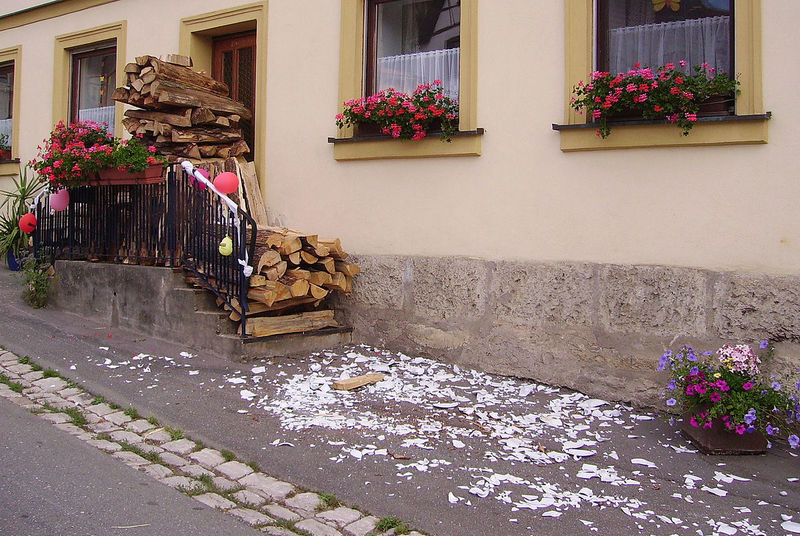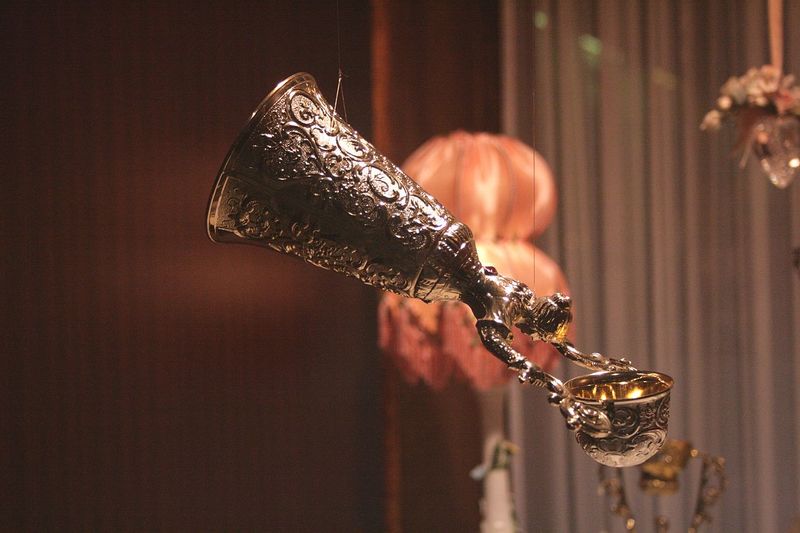German Wedding
German weddings begin with a "Polterabend" party where guests break porcelain for good luck, followed by mandatory civil ceremonies and optional religious services. Traditions include the couple walking to the altar together, sawing a log after the ceremony to symbolize teamwork, and dancing the first waltz at the reception. Unique customs like the Bavarian bridal cup toast, the bride's "kidnapping" to local bars, and playful pranks in the couple's room highlight the festivities.
German Wedding
In the evening before the wedding there is a very famous party held usually in front of the bride's home or the home of her parents. It is known as Polterabend. German verb "poltern" means make lot of noise and "abend" means an evening.

People break large amounts of porcelain or clay plates and other dishes. The more broken pieces the luckier the future of the couple is going to be. Oh yes, you guessed right, the bride and groom have to clean the whole mess.
In Germany a couple must be married in the state office ("Standesbeamte"). A religious wedding ceremony is an option. The most popular month for weddings is May. German couples have the wedding rings on their right hand. They do not include diamonds. An engagement ring is worn on the left hand.
A bride wears a wedding dress during whole day. She does not change it during a wedding reception like in some other countries.
A bride and a groom walk towards the church altar together. After the wedding ceremony the newlyweds get out of the church. People throw rice at them. After that everyone is observing the bride's hair as the number of rice grains in her hair means the number of children the couple is going to have.
There is yet another tradition observed after the wedding ceremony. A bride and groom are sawing a log placed on a sawing horse. This should show how well the newlyweds will function in difficult situations in life.
Then everyone enters their cars and go towards the place where the wedding reception will be held. There is a white ribbon tied to an antenna on the car with the bride and groom. This ribbon is taken out of the bridal flower bouquet. There is also another version of this tradition where a bride gives ribbons for all the cars. There is so much honking.
The newlyweds traditionally dance the first waltz. After that there is a dance involving them and their parents. A bride dances with her father. A groom dances with her mother. A bride's mother dances with groom's father. Only after these dances the bride is allowed to take off the veil. Some brides do not wear a veil at all.
Certainly there is more dancing. Traditionally all other people at the wedding reception who want to dance with a bride or a groom have to pay for it.

In the German province of Bavaria a toast is proposed with a bridal cup (brautbecher, hochzeitsbecher). It is made of glass, silver or even wood. Bride and groom drink wine from it at the same time. This action symbolizes their unity. While drinking they must not spill a single drop.
Like in most parts of the world there is no German wedding reception without a wedding cake. The cake is cut together by the bride and groom.
At midnight the bride takes off her veil and gives it to the woman present among guests who is going to marry next.
In the south of Bavaria there is a funny tradition where the best man, bridesmaids and some friends "kidnap" the bride. She is taken to the local bar. It is the one where the couple often visits. There the kidnappers drink a lot. Then they move to the next bar.
A groom has to go from bar to bar until he finds the bride. In each bar he has pay the bill created by the kidnappers. This bill is actually the ransom. The kidnappers must carry the bridal bouquet. In case they forgot to take it the groom can use it to pay the ransom.
At the wedding reception guests can often buy sort of newspapers made by the bride's and groom's family and friends. It includes Image(s) and lovely details about their life. The collected money should help the couple to finance the honeymoon.
After the wedding reception the happy couple goes to spend their first night together. But their friends and relatives do not agree. They make pranks inside the room to prevent their peace and happiness.
References
Walking Down the Aisle
http://www.germanculture.com.ua/library/weekly/aa030601a.htm
German Wedding Traditions and Customs
http://www.beau-coup.com/german-wedding-traditions.htm
German Wedding Traditions and Customs
http://www.howtogermany.com/pages/german-weddings.html
Polterabend
http://en.wikipedia.org/wiki/Polterabend
German Wedding Traditions
http://germanfoods.org/german-food-facts/german-wedding-traditions/
Traditions and Cultural Oddities
http://www.watzmann.net/scg/faq-2.html#ss2.3
Image(s)
Oktoberfest costume parade blowers - source pixabay.com
Polterabend - photo by Immanuel Giel
Brautbecher - photo by Tamorlan - from the Brautbecher museum in
Goslar (Lower Saxony)